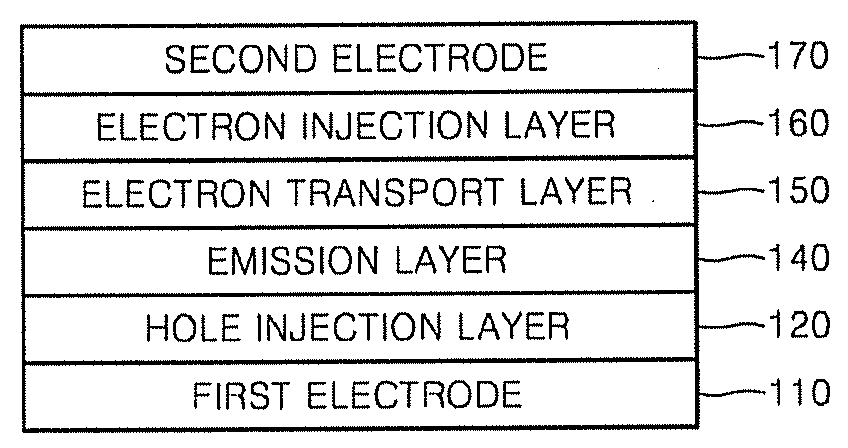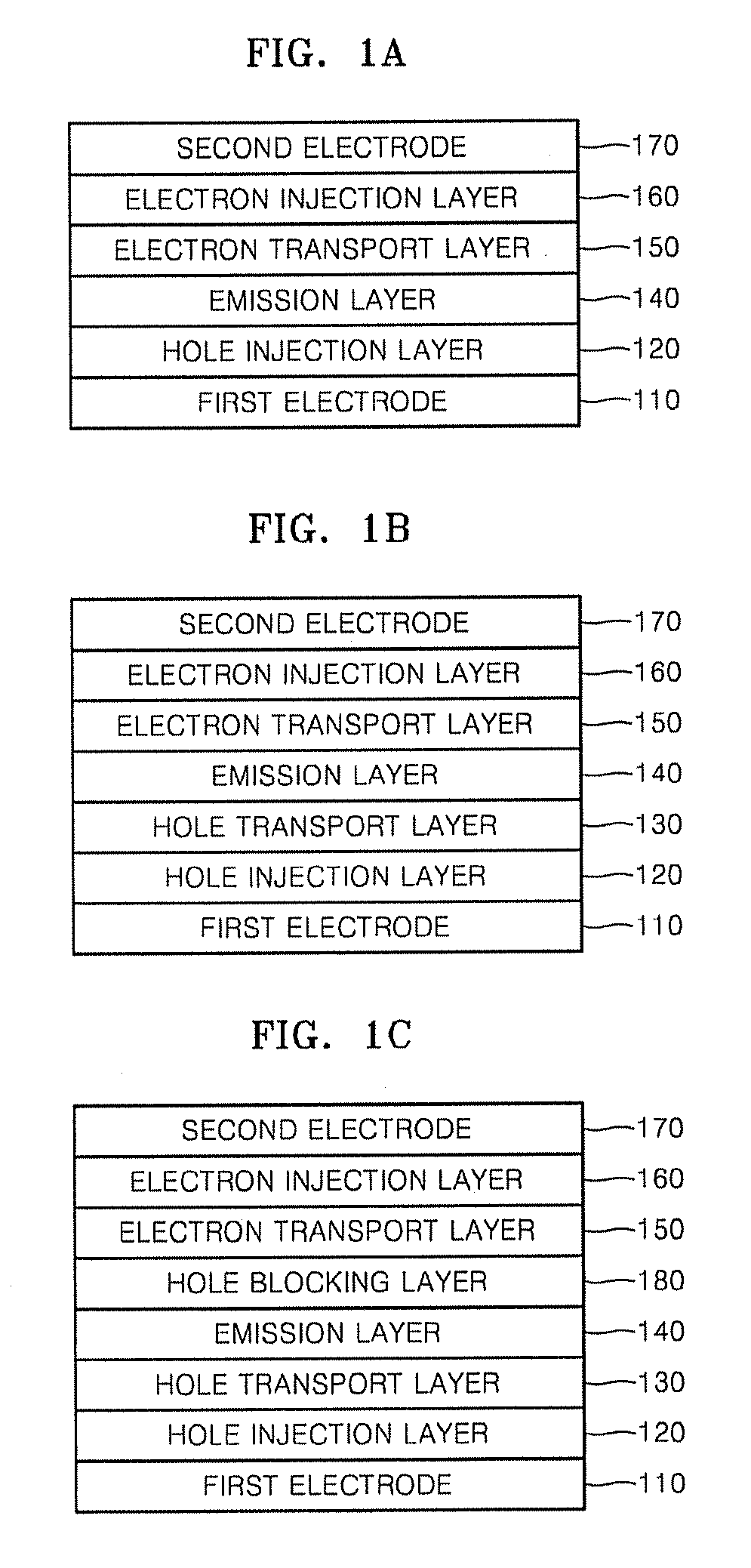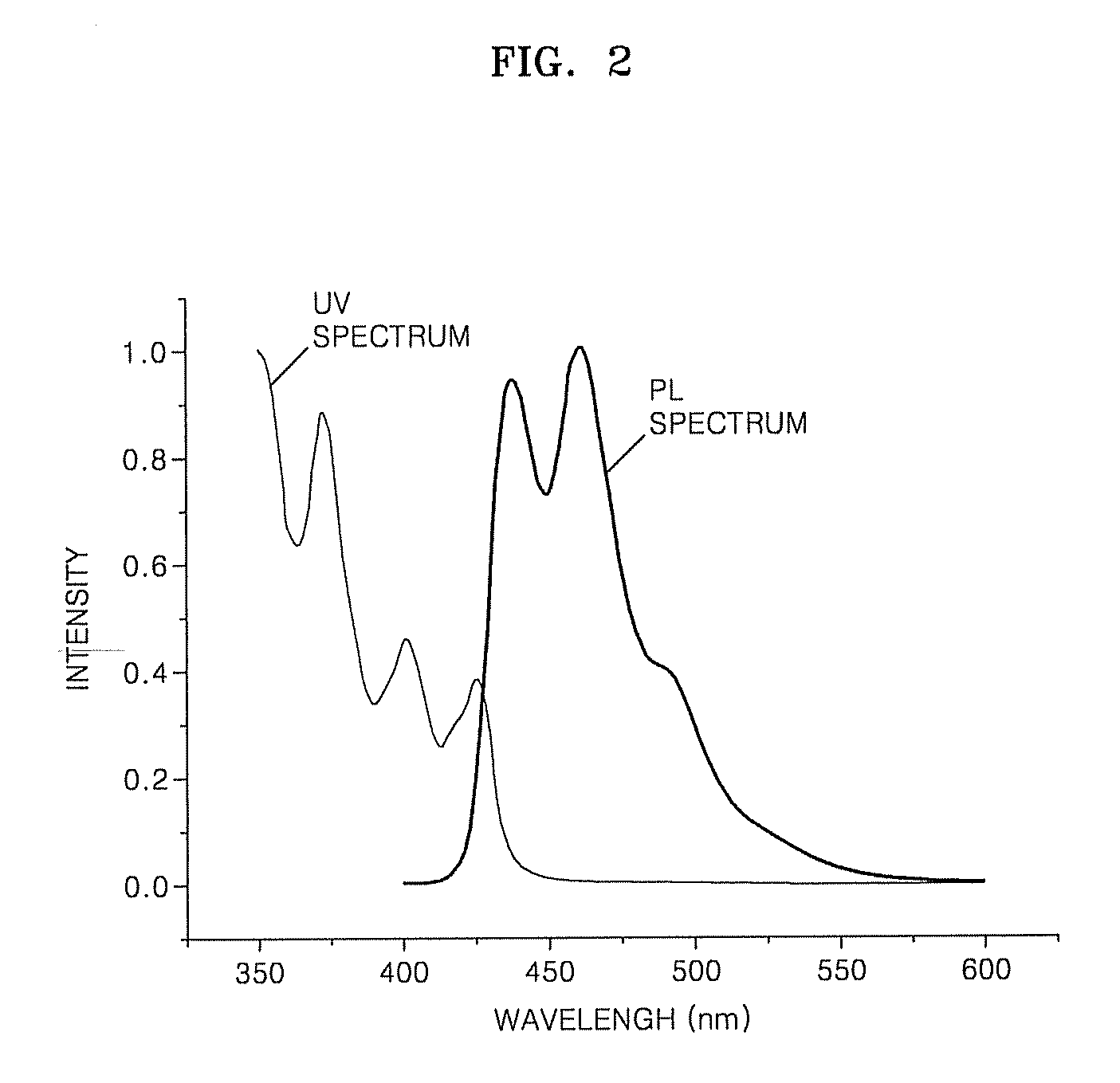Organic light emitting compound, organic light emitting device comprising the same, and method of manufacturing the organic light emitting device
a light emitting device and organic technology, applied in the direction of organic chemistry, discharge tube luminescnet screen, anthracene dyes, etc., can solve the problems of poor and inferior material that can be used in solution coating in terms of thermal stability, color purity and the like, and achieve good solubility and high thermal stability
- Summary
- Abstract
- Description
- Claims
- Application Information
AI Technical Summary
Benefits of technology
Problems solved by technology
Method used
Image
Examples
synthesis example 1
[0095]Compound 3, represented by Formula 3, was synthesized according to Reaction Schemes 1, 2 and 3:
[0096]Synthesis of Intermediate A
[0097]8.4 g of 2,5-dibromonitrobenzene (30 mmol), 10.8 g of 1-naphthaleneboronic acid (62.6 mmol), 520 mg of tetrakis triphenylphosphine palladium (Pd(PPh3)4) (0.45 mmol) and 63 ml of a 2M aqueous potassium carbonate solution (126 mmol) were dissolved in 100 ml of toluene, respectively, and then the mixtures were added to a 500 ml round bottom flask under argon gas. Then, the mixture was refluxed for 24 hours. After the reaction was terminated, a solvent was removed by evaporation. Then, the residue washed with 500 ml of ethyl acetate and 500 ml of water. Thereafter, an organic layer was collected and dried over anhydrous magnesium sulfate. Subsequently, the dried organic layer was purified using silica chromatography to obtain 9.5 g of a compound represented by Intermediate A (yield 84%).
[0098]Synthesis of Intermediate B
[0099]8.0 g of Intermediate A ...
synthesis example 2
[0103]Compound 5 represented by Formula 5 was synthesized according to Reaction Schemes 4, 5 and 6:
[0104]Synthesis of Intermediate C
[0105]729 mg of 2-bromonitrobenzene (3.6 mmol), 1.1 g of 1-(4,4,5,5-tetramethyl-1,3,2-dioxaborolan-2-yl)anthracene (3.6 mmol), 63 mg of tetrakis triphenylphosphine palladium (Pd(PPh3)4) (0.054 mmol) and 3.8 ml of a 2M aqueous potassium carbonate (K2CO3) (7.6 mmol) were dissolved in 12 ml of toluene, respectively, and the mixtures were added to a 500 ml round bottom flask and then refluxed for 24 hours. After the reaction was terminated, the solvent was evaporated and thereby removed. Then, the residue washed with 100 ml of ethyl acetate and 100 ml of water. Thereafter, an organic layer was collected and dried with magnesium sulfate. Subsequently, the dried organic layer was purified using silica chromatography to obtain 880 mg of a compound represented by Intermediate C (yield 81%).
[0106]Synthesis of Intermediate D
[0107]806 mg of Intermediate C (2.7 mmo...
synthesis example 3
[0111]
[0112]Synthesis of Compound 14
[0113]840 mg of Intermediate D (3 mmol), 260 mg of copper (4.0 mmol), 1.2 g of potassium carbonate (8.4 mmol), 85 mg of 18-crown-6-ether (0.32 mmol), 540 mg of 2,3,4,5-tetraphenyl-4-bromophenyl (1 mmol) were dissolved in 6 ml of nitrobenzene, and the mixtures were added to a 500 ml round bottom flask and then refluxed for 24 hours. After the reaction was terminated, the solvent was evaporated and thereby removed. Then, the residue washed with 100 ml of ethyl acetate and 100 ml of water. Thereafter, an organic layer was collected and dried with magnesium sulfate. Subsequently, the dried organic layer was purified by silica chromatography to obtain 490 mg of a compound represented by Compound 14 (yield 67%).
[0114]1H-NMR (CDCl3, 300 MHz, ppm): 9.3-6.9 (m, 37H).
PUM
| Property | Measurement | Unit |
|---|---|---|
| temperature | aaaaa | aaaaa |
| vapor pressure | aaaaa | aaaaa |
| Tm | aaaaa | aaaaa |
Abstract
Description
Claims
Application Information
 Login to View More
Login to View More - R&D
- Intellectual Property
- Life Sciences
- Materials
- Tech Scout
- Unparalleled Data Quality
- Higher Quality Content
- 60% Fewer Hallucinations
Browse by: Latest US Patents, China's latest patents, Technical Efficacy Thesaurus, Application Domain, Technology Topic, Popular Technical Reports.
© 2025 PatSnap. All rights reserved.Legal|Privacy policy|Modern Slavery Act Transparency Statement|Sitemap|About US| Contact US: help@patsnap.com



